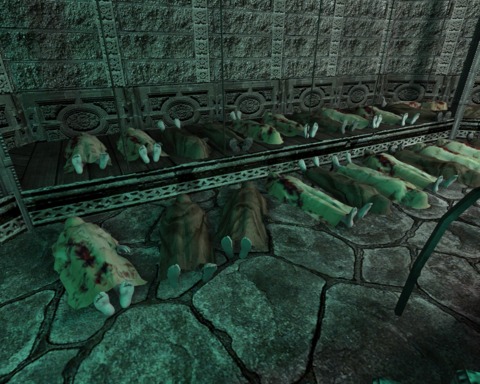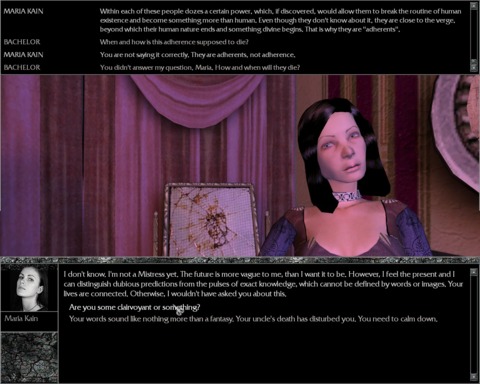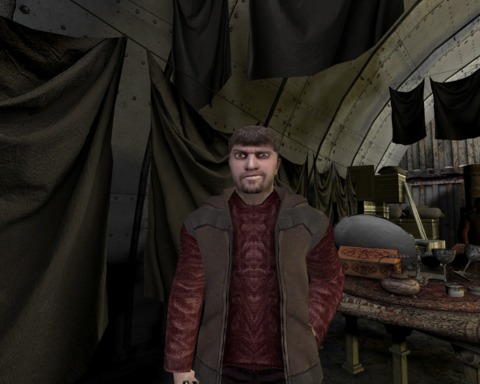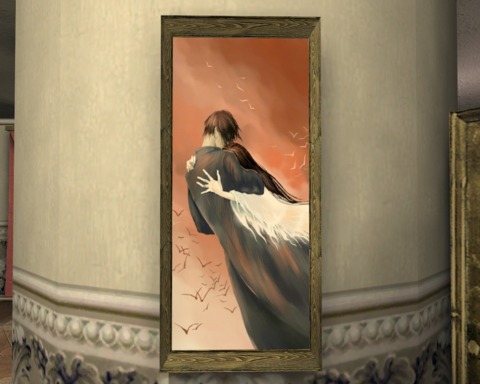A Few Thoughts on Pathologic (2005)
By Wemibelle 6 Comments

If you’re a fan of horror games, you’ve probably heard the name Pathologic brought up at least once or twice. Like many of the genre’s more obscure releases (Rule of Rose, Haunting Ground, etc.), this title has something of a cult following. Those who had the patience to deal with the irregular experience found something worthy of more attention than it initially got . Most noteworthy among these fans was Rock Paper Shotgun’s Quintin Smith, who wrote a brilliant three-part series about his time with the game that is quite well-known, even for those who have never played the game. Ever since I first read this series, I knew I had to see Pathologic for myself, even if I might regret the actual “playing it” part of the process. It’s taken me several years to find the time and energy, but I’ve finally done it: I have finished one (of three) playthroughs. Here are my impressions of the game; they certainly won’t be to the caliber of Butchering Pathologic, but I'll do my best to give some reasons to play, or not play, Pathologic.
In Pathologic, you find yourself in a small village on the eve of a vicious outbreak. Each of the three playable characters--the Butcher, the Haruspex, and the Devotress--are there for different reasons, but all three must contend with the Sand Plague as they struggle to survive over the course of twelve days. You have multiple status bars to manage in order to keep breathing: health, hunger, exhaustion, and infection. While exhaustion can be easily fixed with a bed and some time, the other three stats require items to replenish or bolster. You must buy these items from shops around town, with prices skyrocketing as the plague steadily gets worse, or steal them from the bodies/houses of others--beware the effects theft and murder can have on your reputation, though. Every day brings a new main objective for your character to complete, a task which is required to progress in the story. There are also many side quests to be found from residents of the town, offering valuable money and resources as rewards. Every day is a struggle to survive, pushing through the various infected districts around the village in order to scrounge up necessary supplies or reach your objectives in one piece.

I found Pathologic to be brutally effective because of its complete devotion to its ideas, despite the rough edges that clearly appeared during development. The village, for example, is absolutely huge, with varying district types--residential, industrial, slums, etc.--and important NPCs scattered about believably. While this landmass is impressively dense, it’s also a bit too big, especially considering your lethargic movement speed. Making your way from one end of town to another can take nearly 10 minutes, especially once infected districts begin to spread and you’re forced down alternate paths for safety. To make matters worse, quests like sending you through chains of NPC interactions to progress, many of whom are on opposite sides of the village. Things can certainly happen as you’re walking around, but more often than not, you’ll just be walking down empty street after empty street just to see a bit more character interaction or story.
Combat also features some unevenness. Melee combat was clearly designed with a focus on darting in and out of an enemy’s reach while landing hits of your own, the Muhammed Ali school of fighting. For the most part, this system works: I made it through many encounters, even against multiple enemies, without ever taking a hit, thanks to constant backpedaling and patiently timing my strikes. There is, however, a bit of inconsistency to characters’ reach and animation speed. Many times, I found myself missing an enemy from close range or taking a hit that seemed entirely impossible, forcing me into a situation that necessitated a reload. Ranged combat also features some quirkiness. A gun’s accuracy is supposed to be based on its condition, a stat that decreases with every shot fired. I found that even guns with 100% condition would frequently miss at anything other than close range, even the rifle intended for longer shots. At the same time, firearms are extremely powerful, so you definitely want to use them--even if it means a bit of trial and error through save scumming until a hit actually lands. These systems work on a basic level, but each suffers from a lack of polish, leading to some potential frustration.

Despite its flaws, there are numerous elements of Pathologic that make it a powerfully memorable experience. For example, you choose one of three characters when starting the game. In a clever idea that I haven’t seen elsewhere, the other two characters don’t just vanish; they actually appear in the game as NPCs with their own goals. These other two characters follow the paths that they would if you were actively playing them, despite often being to the detriment of the actual player-controlled character. Even without player agency, each of the three playable characters feel like more than NPCs: each has their own beliefs, morals, and goals during the outbreak and do what they feel is necessary. At its best moments, those other characters feel like real players, people who have no qualms about stepping over you on their way to the endgame.
The world of Pathologic is unlike any other I’ve seen. Both character models and environments are clearly dated by today’s standards, but this actually managed to work in the game’s favor for me: the grotesque proportions and strange designs gave my experience a dreamlike quality, fitting in perfectly with the feel of the game. Creepy, uncomfortable characters like the Dogheads, children wearing the “skin” of stuffed animals on their head, demonstrate that something was clearly wrong with this village even before the plague. In infected districts, the outside walls of houses drip with red pustules and malefic disease clouds relentlessly attempt to infect you. Hanging over the city is the Polyhedron, a physically impossible building splashed with bizarre geometric designs. These elements come together to form a world that is truly singular in my mind, a unsettlingly well-realized place..

Most impressive of all is the story of the game. It starts simply, with your character pursuing the objective that brought him or her to village in the first place. You meet the assorted players around town and are exposed to the basic themes of metaphysics and the unexplainable that persist through the rest of the game. As the plague begins to spread, a focus on fighting back in that character’s own way is added, while also dealing with the interpersonal relationships of the varied parties around town. As the game passes the halfway point, however, things start to get even stranger. Characters you think you know and understand make odd decisions with powerful consequences. Buildings previously unaccessible become available, painting a more horrifying picture of the true nature of the village. Everything culminates in a fascinating series of events that I was entirely not expecting--and that I certainly won’t spoil here. All I can say is that it instantly made all the pain and suffering of the gameplay absolutely worth enduring to see how it turned out.
Sadly, Pathologic’s greatest strength is held back by its greatest weakness: the translation. This game was made by a Russian team, with the translation into English being done out-of-house. Early on, this isn’t a huge problem: basic ideas are understandable, even if the grammar is a bit shaky, and conversations are still simple enough to follow through the ungainly writing. As things become more complicated--more active characters, new locations, deeper plot points--the translation just can’t keep up. Combine this with the fact that there is a LOT of text to be found and you’ll likely have a hard time keeping everything straight or even remaining invested in what’s going on. This unfortunately strips a lot of the impact of the story away, subtle nuances and subtext being impossible to discern in the rough imitation of the original script. Objectives can be a bit unclear at times as well, making it difficult to understand why, for example, the person you are supposed to meet isn’t at the location you were originally told. The translation certainly doesn’t ruin the game, and it’s perfectly playable/understandable with a bit of patience, but it does hold it back from its true potential.

Pathologic is absolutely a flawed game, featuring quirky design and dated elements. Many of its gameplay systems don’t stand up well today, making for a frustrating experience for any modern-minded gamers wishing to revisit it. Having the patience and desire to make it through just one character’s playthrough is tough; all three is practically unheard of. At the same time, the strength of the game’s world and ideas do manage to sometimes overcome its lack of polish. As I mentioned above, Pathologic is a game that isn’t afraid to go for it, utilizing systems that may not be entirely fun but are certainly commendable for what they attempt to do. During its best moments, it wouldn’t feel out of place in today’s landscape of thought-provoking narratives and characters. Still, it’s a hard game to recommend to just anyone: only those with the patience for older game design and an appreciation for cerebral horror will likely enjoy the experience.
While this should be a cause for disappointment, there is some hope on the horizon. Ice PIck Lodge, the developer of Pathologic, is preparing both a remaster of the original title and a brand-new reimagining (funded by Kickstarter). While the reimagining isn’t due out until at least next year, the remaster of the original game is likely going to be released by the end of October. Better yet, this new version will be complete with a redone translation to fix the original game’s script--among other fixes such as new graphical options. A fresh coat of paint and retranslated text aren’t enough to fix every problem I had with Pathologic, but it might just be enough to push it from a hesitant recommendation to a must-play title. For now, I suggest waiting until reception for the remaster hits; a new translation and some bugfixes may be worth the wait.
